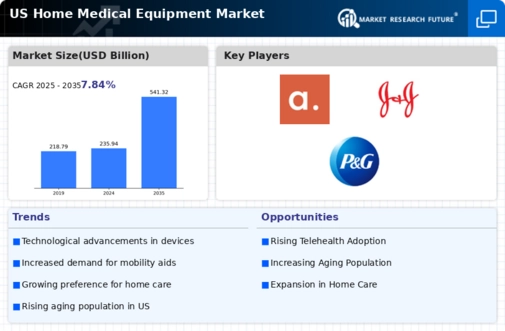Rising Chronic Disease Prevalence
The increasing prevalence of chronic diseases in the US is a pivotal driver for the home medical-equipment market. Conditions such as diabetes, hypertension, and respiratory disorders necessitate ongoing monitoring and management, which can be effectively facilitated through home medical equipment. According to the Centers for Disease Control and Prevention (CDC), approximately 60% of adults in the US have at least one chronic condition, leading to a heightened demand for home-based solutions. This trend is likely to continue, as the aging population further exacerbates the burden of chronic diseases. Consequently, the home medical-equipment market is expected to expand, as patients seek convenient and effective ways to manage their health from home.
Supportive Reimbursement Policies
Supportive reimbursement policies in the US are playing a crucial role in driving the home medical-equipment market. Insurance coverage for home medical devices has expanded, making it more accessible for patients to obtain necessary equipment. This trend is particularly evident in the coverage of durable medical equipment (DME), which includes items such as wheelchairs, oxygen equipment, and home monitoring devices. As reimbursement policies evolve to support home healthcare, patients are more likely to invest in home medical equipment, knowing that their costs may be partially covered. This shift is expected to bolster the market, as financial barriers are reduced, allowing for greater adoption of home medical solutions.
Technological Integration in Healthcare
The integration of advanced technologies into healthcare is transforming the home medical-equipment market. Innovations such as telehealth, remote monitoring, and smart medical devices are enhancing patient care and convenience. The rise of Internet of Things (IoT) devices allows for real-time health data transmission, enabling healthcare providers to monitor patients remotely. This technological evolution not only improves patient outcomes but also reduces the burden on healthcare facilities. As a result, the home medical-equipment market is likely to witness substantial growth, with estimates suggesting a market value exceeding $50 billion by 2027. The ongoing development of user-friendly and efficient devices will further drive this trend.
Growing Consumer Awareness and Education
Consumer awareness regarding health management is on the rise in the US, which is a significant driver for the home medical-equipment market. As individuals become more informed about their health needs, they are increasingly seeking out home medical equipment to assist in managing their conditions. Educational initiatives and marketing campaigns by manufacturers have contributed to this trend, highlighting the benefits of home-based health solutions. This heightened awareness is expected to lead to increased sales of home medical devices, as consumers recognize the value of monitoring their health from the comfort of their homes. The market is anticipated to grow as more individuals prioritize health management and seek out appropriate equipment.
Increased Focus on Preventive Healthcare
There is a growing emphasis on preventive healthcare in the US, which significantly influences the home medical-equipment market. As healthcare costs continue to rise, both consumers and healthcare providers are prioritizing preventive measures to reduce the incidence of severe health issues. Home medical equipment plays a crucial role in this paradigm shift, enabling individuals to monitor their health proactively. For instance, devices such as blood pressure monitors and glucose meters empower patients to take charge of their health, potentially reducing hospital visits. This trend is reflected in the market, which is projected to grow at a CAGR of around 8% over the next few years, driven by the increasing adoption of home-based health monitoring solutions.














Leave a Comment